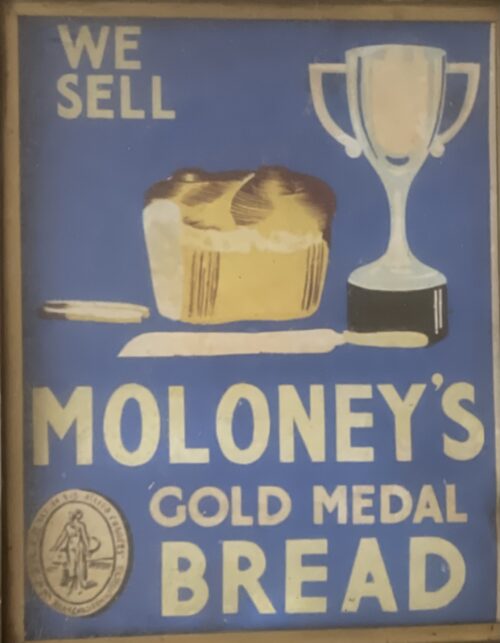-
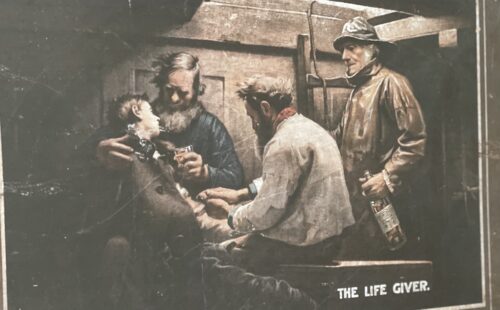
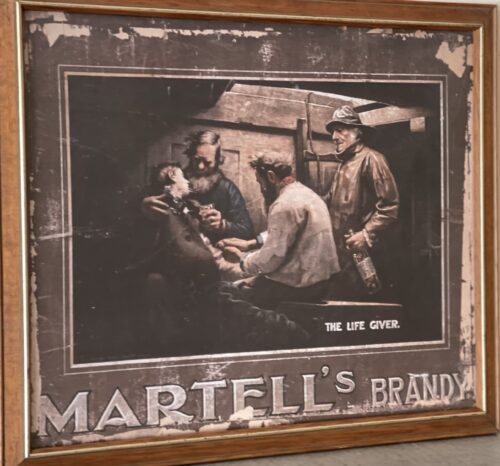 40cm x 34cm Limerick Martell is a Cognac house founded in 1715 by Jean Martell (1694–1753). It is part of the Martell Mumm Perrier-Jouët subsidiary of the French wines and spirits conglomerate Pernod Ricard. In 1715, Jean Martell, a young merchant originally from Jersey, created his own trading business at Gatebourse in Cognac, on the banks of the Charente, and thus founded one of the first cognac houses. Martell used grapes from the vineyards in the Borderie subregion, and used Tronçais oak for its casks, this made a combination that resulted in an exceptionally smooth cognac.After his death in 1753, his widow and then his two sons and grandson continued this tradition and developed the export business to make Martell the number one in England in 1814. In 1831, Martell created his first "VSOP" (Very Superior Old Pale) cognac and continued its international expansion. Its fame spread throughout the world, with the first exports to Japan and other Asian markets, such as Indonesia, Vietnam, Malaysia and Korea. On the coat of arms are what appear to be three small martels or war hammers, but could also be keg mallets. Cordon Bleu, created in 1912, is certainly the company’s most famous product. Martell was served aboard the Queen Mary in 1936 and even on Concorde in 1977. In 1987, Seagram took control of the French manufacturer for $1.2 billion. Since the acquisition of some of the Seagram Group’s spirits in 2001, Martell has belonged to the French spirits group, Pernod Ricard. In the 2000s, Martell created new cognacs: "Martell XO" in 2005, "Martell Création Grand Extra" in 2007, in a bottle designed by the artist and glass designer Serge Mansau. In 2009, Martell cognac launched its signature cognac, "L'Or de Jean Martell". In 2011, Martell expanded its "ultra-prestige" range with an exceptional cognac, "Martell Chanteloup Perspective", a tribute to the know-how of the cellar masters and to the Domaine de Chanteloup. In 2006, Martell joined the Comité Colbert, an association that promotes French luxury houses on an international scale. In 2010, Martell renewed its sponsorship with the Palace of Versailles, which began in 2007, by supporting the restoration of the Queen’s antechamber. In 2012, Martell Cordon Bleu, which was launched by Edouard Martell in 1912 at the Hotel de Paris in Monaco, celebrated its 100th birthday in the same place.
40cm x 34cm Limerick Martell is a Cognac house founded in 1715 by Jean Martell (1694–1753). It is part of the Martell Mumm Perrier-Jouët subsidiary of the French wines and spirits conglomerate Pernod Ricard. In 1715, Jean Martell, a young merchant originally from Jersey, created his own trading business at Gatebourse in Cognac, on the banks of the Charente, and thus founded one of the first cognac houses. Martell used grapes from the vineyards in the Borderie subregion, and used Tronçais oak for its casks, this made a combination that resulted in an exceptionally smooth cognac.After his death in 1753, his widow and then his two sons and grandson continued this tradition and developed the export business to make Martell the number one in England in 1814. In 1831, Martell created his first "VSOP" (Very Superior Old Pale) cognac and continued its international expansion. Its fame spread throughout the world, with the first exports to Japan and other Asian markets, such as Indonesia, Vietnam, Malaysia and Korea. On the coat of arms are what appear to be three small martels or war hammers, but could also be keg mallets. Cordon Bleu, created in 1912, is certainly the company’s most famous product. Martell was served aboard the Queen Mary in 1936 and even on Concorde in 1977. In 1987, Seagram took control of the French manufacturer for $1.2 billion. Since the acquisition of some of the Seagram Group’s spirits in 2001, Martell has belonged to the French spirits group, Pernod Ricard. In the 2000s, Martell created new cognacs: "Martell XO" in 2005, "Martell Création Grand Extra" in 2007, in a bottle designed by the artist and glass designer Serge Mansau. In 2009, Martell cognac launched its signature cognac, "L'Or de Jean Martell". In 2011, Martell expanded its "ultra-prestige" range with an exceptional cognac, "Martell Chanteloup Perspective", a tribute to the know-how of the cellar masters and to the Domaine de Chanteloup. In 2006, Martell joined the Comité Colbert, an association that promotes French luxury houses on an international scale. In 2010, Martell renewed its sponsorship with the Palace of Versailles, which began in 2007, by supporting the restoration of the Queen’s antechamber. In 2012, Martell Cordon Bleu, which was launched by Edouard Martell in 1912 at the Hotel de Paris in Monaco, celebrated its 100th birthday in the same place. -

 45cm x 34cm The Midland Great Western Railway (MGWR) was the third largest Irish gauge (1,600 mm (5 ft 3 in)) railway company in Ireland. It was incorporated in 1845 and absorbed into the Great Southern Railways in 1924. At its peak the MGWR had a network of 538 miles (866 km), making it Ireland's third largest network after the Great Southern and Western Railway(GS&WR) and the Great Northern Railway of Ireland. The MGWR served part of Leinster, County Cavan in Ulster and much of Connacht. Its network was entirely within what in 1922 became the Irish Free State.
45cm x 34cm The Midland Great Western Railway (MGWR) was the third largest Irish gauge (1,600 mm (5 ft 3 in)) railway company in Ireland. It was incorporated in 1845 and absorbed into the Great Southern Railways in 1924. At its peak the MGWR had a network of 538 miles (866 km), making it Ireland's third largest network after the Great Southern and Western Railway(GS&WR) and the Great Northern Railway of Ireland. The MGWR served part of Leinster, County Cavan in Ulster and much of Connacht. Its network was entirely within what in 1922 became the Irish Free State.Early development
The Midland Great Western Railway Act received the Royal Assent in July 1845, authorising it to raise £1,000,000 capitaland to build a railway from Dublin to Mullingar and Longford and to buy the Royal Canal. Construction of the main line began from Dublin in January 1846 and proceeded westwards in stages, supervised by chief engineer G. W. Hemans. It opened from Dublin Broadstoneas far as Enfield in May 1847,to Hill of Down in December 1847 and to Mullingar in October 1848Dublin to Galway
Rivalry existed between the MGWR and the GS&WR, each of which wanted to build the line to Galway. The MGWR extended its line from Mullingar and the GS&WR from its line at Portarlington. The MGWR was first, going via Athlone and reaching Galway, 126.5 miles (203.6 km) from Dublin, in August 1851.It was not until 1859 that the GS&WR got as far as Athlone. The GS&WR was obliged to operate its service over MGWR track between Athlone and Galway, paying the MGWR 65% of passenger and 55% of goods receipts. The GS&WR retained a separate station, which is now the sole operating station, as the last service to the MGWR station ran on 13 January 1985.. The branch is to be made into a rail trail as part of the Dublin-Galway Greenway by 2020.Galway to Clifden
In 1890 the Government granted the MGWR £264,000 to build a railway to Clifdenon the Atlantic coast of County Galway. It opened as far as Oughterard in January 1895 and to Clifden in July 1895.Due to its inland route it did not serve the bulk of the area's population, so the GSR closed it in 1935. A similar branch line was built at the same time from Westport to Achill on the Atlantic coast of County Mayo. The MGW built the first section, opening it as far as Newport in February 1894 and Mulranny in May 1894.The Board of Works built the section from Mulranny to Achill, which opened in May 1895.The GSR closed the line in 1937.Branch lines
At its peak the MGWR had a number of branch lines: Tunnel at Newport on the Westport to Achill branch line.
Tunnel at Newport on the Westport to Achill branch line.- Clonsilla to Navan (opened as the Dublin and Meath Railway 1862, leased to the MGWR 1869, sold to the MGWR 1888)
- extension from Navan to Kingscourt, (opened by the Navan and Kingscourt Railway 1865, sold to the MGWR 1888)
- Kilmessan Junction to Athboy (opened 1864, closed 1963)
- Nesbitt Junction (near Enfield) to Edenderry (opened 1877, closed 1963)
- Streamstown to Clara, County Offaly (opened 1863, closed 1963)
- Attymon Junction to Loughrea (light railway worked by the MGWR, opened 1890)
- Galway to Clifden (opened 1895, closed 1935)
- Westport to Achill (opened 1895, closed 1937)
- Inny Junction to Cavan Town (opened 1856, closed 1960)
- Kilfree Junction railway station to Ballaghaderreen (opened by the Sligo and Ballaghaderreen Railway 1874, sold to the MGWR 1877, closed 1963)
- Crossdoney to Killeshandra (opened 1886, closed 1960)
- Athlone to Westport (opened by the Great Northern and Western Railway 1860–66, leased to the MGWR 1870, sold to the MGWR 1890)
- Claremorris to Ballinrobe (light railway worked by the MGWR, opened 1892, closed 1960)
- Manulla to Ballina, County Mayo (opened 1873)
- extension from Ballina to Killala (opened 1893, closed 1937)
Consolidation
In 1924 the Oireachtas of the Irish Free State passed the Railways Act, which that November merged the MGWR with the Great Southern and Western Railway(GS&WR), Cork, Bandon and South Coast Railway to form the Great Southern Railway. In January 1925, that was joined by the Dublin and South Eastern Railwayto form the Great Southern Railways.Locomotives and rolling stock
Locomotives and rolling stock were maintained at MGWR's Broadstone works in Dublin.Livery
The MGWR painted all of its locomotives bright emeralduntil about 1902, when the first of the new Class A 4-4-0 express locomotives were outshopped in royal blue.This did not wear well and in 1905 the company adopted grass green. From about 1913 locos were painted gloss blackuntil the MGWR became part of the GSR in 1925. From then on, all locomotives were gradually repainted plain unlined dark grey. Passenger coaches were finished in varnish or brown paint until the blue livery was introduced in 1901. As on the locomotives this weathered badly and from 1905 the MGWR reverted to brown,which after 1910 was not so well-adorned with lining.From October 1918 coaches were painted a very dark Crimson and after 1924 the GSR used a similar shade for some years.Preservation
No MGWR locomotive has been preserved but several of its six-wheeled carriages exist.- No. 25 - Downpatrick and County Down Railway. Originally a full 2nd, this coach is on display in the carriage gallery awaiting restoration.
- No. 47 - Ulster Folk and Transport Museum. Built in 1844 and notable for being used as William Dargan's private saloon. Fully restored.
- No. 47M - This carriage used to be based at the DCDR, but unfortunately had to be scrapped.
- No. 53 - Downpatrick and County Down Railway. Originally a full 2nd, this coach is on display in the carriage gallery awaiting restoration.
- No. 62M - Railway Preservation Society of Ireland. A full 3rd, this carriage is meant to be under restoration for use at the DCDR.
- No. 84 - Clifden. Intended to be restored as part of the Station House Hotel's collection.
Present day
Those of the former MGWR's main lines that are still open are owned and operated by Iarnród Éireann. Routes between Dublin and Sligo, Athlone and Galway, Athlone and Westport and the Ballina branch remain open to passenger traffic. The Meath on Track campaign is campaigning to have the Navan — Clonsilla line (not to be confused with the former GNR Navan — Drogheda line) reopened earlier than the 2030 date announced under current Iarnród Éireann policy.The Edenderry, Clifden, Achill, Cavan, Killeshandra, Ballaghaderreen branch line, Ballinrobe, Killala and Loughrea branches lines are all closed. Rail Users Ireland proposed running some Galway — Dublin services via the MGWR station in Athlone and the disused route via Moate to Mullingar, reinstating the route of the first MGWR service via the former GS&WR line. The current Galway service runs from Dublin Heuston. This proposal will not go ahead as the railway is due to be replaced with the Dublin-Galway greenway starting from 2020. Three former MGWR stations are now hotels, two of which are called the "Station House Hotel" but are unconnected by ownership. They are the expanded former Clifden station in County Galway, Kilmessan Junction in County Meath and the Mullranny Park Hotel at Mulranny, County Mayo. The Great Western Greenway is a greenway rail trail that uses the route of the former Westport — Achill branch line. -

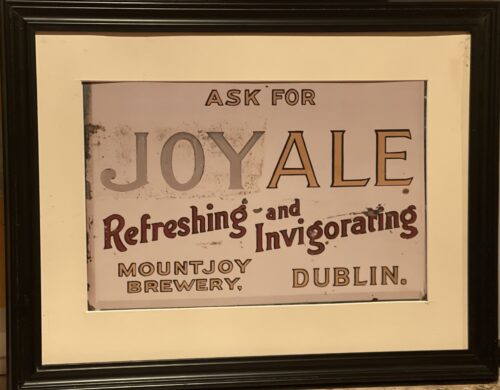 44cm x 52cmMountjoy Brewery Ltd, Russell Street, Dublin, Ireland. Founded 1852. Known as Findlater & Co. until June 1891. Closed 1957. From the Brewery History society Journal Number 91 Founded by Alexander Findlater, a Scottish businessman, in 1852. Primarily a porter brewer but later ale brewers. They enjoyed local, military and export trade with markets in the UK and the colonies. The brewery passed into the hands of Messrs Malone & Blood in 1900 and had by this time become the largest exporter of porter next to Guinness through the port of Dublin. It outlived all its rivals in Dublin apart from Guinness and closed in 1957.
44cm x 52cmMountjoy Brewery Ltd, Russell Street, Dublin, Ireland. Founded 1852. Known as Findlater & Co. until June 1891. Closed 1957. From the Brewery History society Journal Number 91 Founded by Alexander Findlater, a Scottish businessman, in 1852. Primarily a porter brewer but later ale brewers. They enjoyed local, military and export trade with markets in the UK and the colonies. The brewery passed into the hands of Messrs Malone & Blood in 1900 and had by this time become the largest exporter of porter next to Guinness through the port of Dublin. It outlived all its rivals in Dublin apart from Guinness and closed in 1957.Entry in the Trade Mark Registry Registration No : 5,664 Description : Three castles in shield Date of Application : 13/5/1876 Used Prior to 1875? : 10 years
Registration No : 5,665 Description : Crown in shield Date of Application : 13/5/1876 Used Prior to 1875? : 10 years Registration No : 156,739 Description : Label design Date of Application : 26/5/1891 Used Prior to 1875? : Since Aug 1875 Registration No : 372,597 Description : Joy (word) Date of Application : 19/04/1916 Used Prior to 1875? : NO -

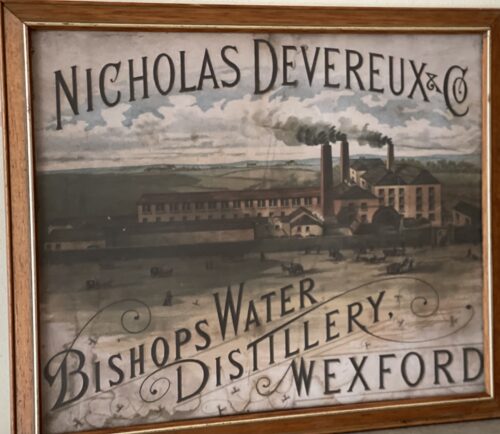 40cm x 34cm LimerickBishops Water Distillery(subsequently known as Nicholas Devereux Finest Irish Whisky) was an Irish whiskey distillery which operated in Wexford, Ireland between 1827 and 1914. The distillery was named for a stream which ran along the back of the distillery, the Bishop's Water, said to possess "various occult properties derived from the blessings of the sainted Bishop of Ferns". Constructed at a cost of £30,000, the distillery was reported to be “reckoned the most perfect and complete of the kind in Ireland”.In 1833, just a few years after it opened, the distillery recorded an output of about 200,000 gallons per annum .However, output had fallen to just 110,000 gallons per annum in 1886, when the distillery was visited by Alfred Barnard, as recorded in his seminal 1887 publication "The Whisky Distilleries of the United Kingdom". This was amongst the lowest output of any distillery operating in Ireland at the time, and far below the potential output of 250,000 gallons per annum reported when the distillery was offered for sale as a going concern in 1909. The distillery's whiskey, Barnard noted, was highly appreciated locally, and in the British cities where it was exported. In the early 20th century, with the Irish whiskey industry in decline, Bishop's Water distillery, like the majority of distilleries in Ireland at the time, suffered serious financial difficulties, and entered bankruptcy. Following its closure, the distillery was initially converted into an iron works (Pierce Ironworks). However, much of the site was later demolished, and little evidence of the distillery still remains. Some mementos can still be found in locals pubs, while a stone archway known to have been extant in 1903 and now bearing the inscription "Casa Rio", possibly in reference to the location of a Pierce ironworks office in Buenos Aires, marks the entrance to the site where the distillery once stood, on Distillery Road. In 1827, a whiskey distillery was established on what is now Distillery Road, Wexford by a consortium of businessmen. The consortium which traded under "Devereux, Harvey, and Co., Distillers", comprised a number of local businessmen, including Nicholas Devereux, his father John Devereux, and Maurice Crosbie Harvey. John Devereux had previously operated a small distillery in the area in the late 1700s, but will little success. In 1830, one of the partners, Maurice Harvey, was accidentally killed at the distillery by an excise man who was taking aim at some birds flying overhead. A few years later, in 1836, the partnership was dissolved at the mutual consent of the remaining partners, with Nicholas Devereux taking sole ownership of the distillery, after which the distillery traded under the name Nicholas Devereux & Son.On his death in 1840, operation of the distillery was taken over by his son Richard. Nichloas Devereux's granddaughter, Mary Anne Therese was also deeply involving in the distilling industry. She married John Locke, founder of the larger Kilbeggan distillery, and successfully took over the business operations of the distillery on his death in 1868. According to Alfred Barnard, the British journalist who visited Bishop's Water in the 1880s, the distillery produced triple-distilled "old pot still whiskey", which was sold locally in Ireland, and also exported to London, Liverpool, and Bristol. At the time of his visit, the Malt Warehouses on-site contained over 16,000 barrels of pure malt. In addition, upwards of 3,000 casks of whiskey were undergoing maturation at the distillery. Whiskey from the distillery is also noted to have been used in the production of blended whiskeys in later years. In the early 20th century, the distillery suffered financial difficulties. In 1907, an attempt was made to appoint a receiver, and in 1909, the distillery was put up for sale, but no takers could be found.In 1914, distilling eventually ceased at the site, and the remaining stocks were sold off.
40cm x 34cm LimerickBishops Water Distillery(subsequently known as Nicholas Devereux Finest Irish Whisky) was an Irish whiskey distillery which operated in Wexford, Ireland between 1827 and 1914. The distillery was named for a stream which ran along the back of the distillery, the Bishop's Water, said to possess "various occult properties derived from the blessings of the sainted Bishop of Ferns". Constructed at a cost of £30,000, the distillery was reported to be “reckoned the most perfect and complete of the kind in Ireland”.In 1833, just a few years after it opened, the distillery recorded an output of about 200,000 gallons per annum .However, output had fallen to just 110,000 gallons per annum in 1886, when the distillery was visited by Alfred Barnard, as recorded in his seminal 1887 publication "The Whisky Distilleries of the United Kingdom". This was amongst the lowest output of any distillery operating in Ireland at the time, and far below the potential output of 250,000 gallons per annum reported when the distillery was offered for sale as a going concern in 1909. The distillery's whiskey, Barnard noted, was highly appreciated locally, and in the British cities where it was exported. In the early 20th century, with the Irish whiskey industry in decline, Bishop's Water distillery, like the majority of distilleries in Ireland at the time, suffered serious financial difficulties, and entered bankruptcy. Following its closure, the distillery was initially converted into an iron works (Pierce Ironworks). However, much of the site was later demolished, and little evidence of the distillery still remains. Some mementos can still be found in locals pubs, while a stone archway known to have been extant in 1903 and now bearing the inscription "Casa Rio", possibly in reference to the location of a Pierce ironworks office in Buenos Aires, marks the entrance to the site where the distillery once stood, on Distillery Road. In 1827, a whiskey distillery was established on what is now Distillery Road, Wexford by a consortium of businessmen. The consortium which traded under "Devereux, Harvey, and Co., Distillers", comprised a number of local businessmen, including Nicholas Devereux, his father John Devereux, and Maurice Crosbie Harvey. John Devereux had previously operated a small distillery in the area in the late 1700s, but will little success. In 1830, one of the partners, Maurice Harvey, was accidentally killed at the distillery by an excise man who was taking aim at some birds flying overhead. A few years later, in 1836, the partnership was dissolved at the mutual consent of the remaining partners, with Nicholas Devereux taking sole ownership of the distillery, after which the distillery traded under the name Nicholas Devereux & Son.On his death in 1840, operation of the distillery was taken over by his son Richard. Nichloas Devereux's granddaughter, Mary Anne Therese was also deeply involving in the distilling industry. She married John Locke, founder of the larger Kilbeggan distillery, and successfully took over the business operations of the distillery on his death in 1868. According to Alfred Barnard, the British journalist who visited Bishop's Water in the 1880s, the distillery produced triple-distilled "old pot still whiskey", which was sold locally in Ireland, and also exported to London, Liverpool, and Bristol. At the time of his visit, the Malt Warehouses on-site contained over 16,000 barrels of pure malt. In addition, upwards of 3,000 casks of whiskey were undergoing maturation at the distillery. Whiskey from the distillery is also noted to have been used in the production of blended whiskeys in later years. In the early 20th century, the distillery suffered financial difficulties. In 1907, an attempt was made to appoint a receiver, and in 1909, the distillery was put up for sale, but no takers could be found.In 1914, distilling eventually ceased at the site, and the remaining stocks were sold off. -
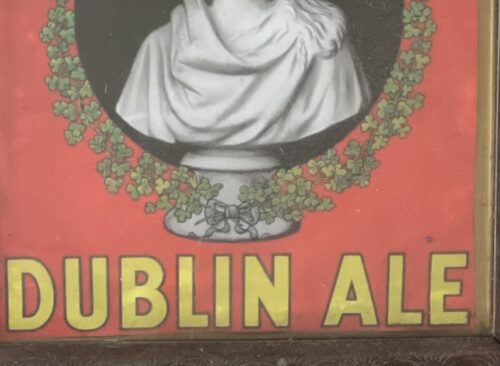
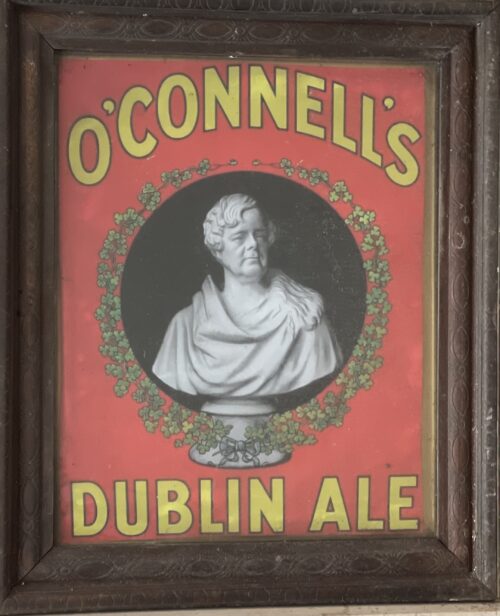 67cm x 56cm
67cm x 56cmDaniel O’Connnell Jr. had famously acquired the Phoenix Brewery in James’s street in 1831, which produced O’Connell’s Ale. It should be noted that O’Connell and the Guinness family were at times political rivals, something best captured by the 1841 ‘Repeal Election’, where O’Connell had stood against and defeated Arthur Guinness Jr. This period would see a sizeable boycott of Guinness, dubbed “Protestant Porter” by sections of the populace, though this was against the wishes of O’Connell himself.
John D’Arcy continued to brew O’Connell Ale after the family had ceased their role in brewing, and in time production moved to the Anchor Brewery in Usher Street. Watkins eventually took up the brewing of O’Connell Ale, and this advertisement was placed by them in the pages of leading newspapers in the 1930s.
While Arthur had failed to defeat O’Connell at the Ballot Box, I always wonder what O’Connell would think of the Guinness Empire today every time I see a Diaego truck pass his statue.
-

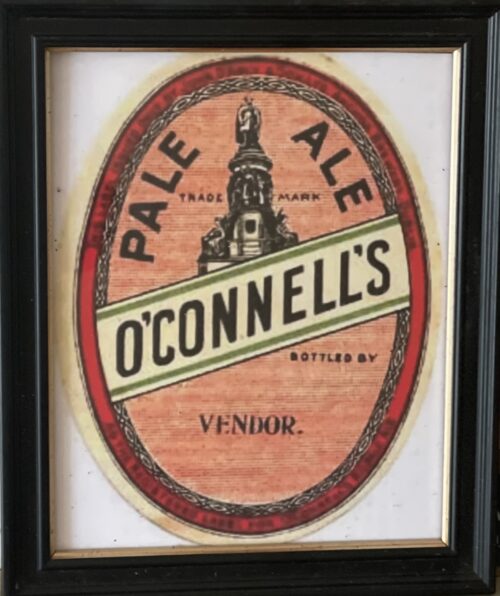 32cm x 27cm
32cm x 27cmDaniel O’Connnell Jr. had famously acquired the Phoenix Brewery in James’s street in 1831, which produced O’Connell’s Ale. It should be noted that O’Connell and the Guinness family were at times political rivals, something best captured by the 1841 ‘Repeal Election’, where O’Connell had stood against and defeated Arthur Guinness Jr. This period would see a sizeable boycott of Guinness, dubbed “Protestant Porter” by sections of the populace, though this was against the wishes of O’Connell himself.
John D’Arcy continued to brew O’Connell Ale after the family had ceased their role in brewing, and in time production moved to the Anchor Brewery in Usher Street. Watkins eventually took up the brewing of O’Connell Ale, and this advertisement was placed by them in the pages of leading newspapers in the 1930s.
While Arthur had failed to defeat O’Connell at the Ballot Box, I always wonder what O’Connell would think of the Guinness Empire today every time I see a Diaego truck pass his statue.
-

 47cm x 37cm LimerickMuch of the last century, and indeed for well over half of the present one, Limerick's importance was directly attributed to her three well-known bacon factories, namely, J. Matterson & Sons, Roches Street, established in 1816 by Mr. John Russell, a Cumberland man in con-junction with Mr. Matterson, using the method of curing then current in Berwick-on-Tweed. W.J. Shaw & Sons, founded in the year 1831 at Mulgrave Street by William John Shaw, a descendant of a County Down family, and O'Mara's bacon factory, Roches Street, which had its origin in Mungret Street some few years before 1839, when James O'Mara from Toomevara started curing bacon in the basement of his house there. Apparently, this basement business flourished, for in 1839 he moved to Roches Street to the premises it last occupied .About the middle of the last century, for some reason now difficult to fathom, Limerick bacon and especially Limerick hams, became well-known for their excellent flavour throughout the English-speaking world. It is on record that Glasgow curers in an effort to produce hams equal in excellence to those of Limerick, imported Limerick workmen who were supposed to know all about the way in which the meat was turned out at home. Apparently, they did not bring secrets with them for their efforts were unsuccessful. There were also much larger bacon factories in parts of the British Isles; for instance, Belfast is reputed to have exported four times the number of hams produced in Limerick, and places like Glasgow and Liverpool had several factories producing very large quantities of bacon as well. None of them, however, quite matched' those produced in the three local factories for flavour and quality.O’MARA’S, MATTERSON’S, SHAW’S and Denny’s were the names that made Limerick famous for its bacon produce for 180 years – earning it the nickname ‘Pigstown’. The reputation of Limerick ham, the food culture that arose from a plentiful supply of cheap products, the story of the pork butchers, the pig buyers, the sounds of the city with factory horns signalling the call to work – all of these still resonate in Limerick in the memories of its citizens and former workers. A definitive account of this industry that operated at the centre of the city, supplied by the farms of rural county Limerick for over 180 years will be documented in a new book called Pigtown – A History of Limerick’s Bacon Industry. Ruth Guiry was commissioned to undertake the research under the guidance of Dr Maura Cronin from Mary Immaculate College and one of the 27 people she interviewed to understand the role the bacon factories had in Limerick was Joe Hayes. Joe Hayes started working in a bacon factory in 1962, aged 16 years old. He worked with his dad, and later on with his two sons until the factory closed in 1986. “When the factory closed, a group of us got our own little unit, we rented it, and produced our own sausages, puddings and things.” It was a huge part of Limerick’s social scene: four generations of Joe’s family worked in bacon factories, with uncles, sisters, brothers, sons and cousins all working in the factory at one time or another: “If one factory was caic, you wouldn’t have a problem getting a job in the other one. And he doesn’t mince his word when talking about the work they did. “They brought the pigs in, we killed the pigs, and prepared the bacon: that’s the way it was in the bacon factories.” When asked about if there were ever animal cruelty protests, he laughs at the idea.
47cm x 37cm LimerickMuch of the last century, and indeed for well over half of the present one, Limerick's importance was directly attributed to her three well-known bacon factories, namely, J. Matterson & Sons, Roches Street, established in 1816 by Mr. John Russell, a Cumberland man in con-junction with Mr. Matterson, using the method of curing then current in Berwick-on-Tweed. W.J. Shaw & Sons, founded in the year 1831 at Mulgrave Street by William John Shaw, a descendant of a County Down family, and O'Mara's bacon factory, Roches Street, which had its origin in Mungret Street some few years before 1839, when James O'Mara from Toomevara started curing bacon in the basement of his house there. Apparently, this basement business flourished, for in 1839 he moved to Roches Street to the premises it last occupied .About the middle of the last century, for some reason now difficult to fathom, Limerick bacon and especially Limerick hams, became well-known for their excellent flavour throughout the English-speaking world. It is on record that Glasgow curers in an effort to produce hams equal in excellence to those of Limerick, imported Limerick workmen who were supposed to know all about the way in which the meat was turned out at home. Apparently, they did not bring secrets with them for their efforts were unsuccessful. There were also much larger bacon factories in parts of the British Isles; for instance, Belfast is reputed to have exported four times the number of hams produced in Limerick, and places like Glasgow and Liverpool had several factories producing very large quantities of bacon as well. None of them, however, quite matched' those produced in the three local factories for flavour and quality.O’MARA’S, MATTERSON’S, SHAW’S and Denny’s were the names that made Limerick famous for its bacon produce for 180 years – earning it the nickname ‘Pigstown’. The reputation of Limerick ham, the food culture that arose from a plentiful supply of cheap products, the story of the pork butchers, the pig buyers, the sounds of the city with factory horns signalling the call to work – all of these still resonate in Limerick in the memories of its citizens and former workers. A definitive account of this industry that operated at the centre of the city, supplied by the farms of rural county Limerick for over 180 years will be documented in a new book called Pigtown – A History of Limerick’s Bacon Industry. Ruth Guiry was commissioned to undertake the research under the guidance of Dr Maura Cronin from Mary Immaculate College and one of the 27 people she interviewed to understand the role the bacon factories had in Limerick was Joe Hayes. Joe Hayes started working in a bacon factory in 1962, aged 16 years old. He worked with his dad, and later on with his two sons until the factory closed in 1986. “When the factory closed, a group of us got our own little unit, we rented it, and produced our own sausages, puddings and things.” It was a huge part of Limerick’s social scene: four generations of Joe’s family worked in bacon factories, with uncles, sisters, brothers, sons and cousins all working in the factory at one time or another: “If one factory was caic, you wouldn’t have a problem getting a job in the other one. And he doesn’t mince his word when talking about the work they did. “They brought the pigs in, we killed the pigs, and prepared the bacon: that’s the way it was in the bacon factories.” When asked about if there were ever animal cruelty protests, he laughs at the idea.
They started at 8am and finished at 5.30 working a 40 hour week when the factory closed in 1986, but despite their work, the people who worked in factories often couldn’t afford to buy the expensive cuts of meat. After the expensive cuts were prepared, the offal, the spare ribs, the pigs’ heads would go to the poorer people. “The blood was used to make the pudding, the packet, the tripe was made off the belly. Everything was used off the pig, and it fed Limerick city.” It was a way of life down in Limerick, so when the factories closed, thousands of people working in a bacon factories were out of jobs, and thousands of families were affected. But it wasn’t the competition from big supermarkets that did it – it was free trade. The Danes, the French, the Dutch all started exporting their products here, and Limerick factories didn’t have the money to export to compete. “Michael O’Mara’s funeral was this week – he was the last of the bacon factory managers.” says Joe. “After the Limerick factory closed, he tried doing different bits and pieces, but nothing worked out for him, so he worked in a factory for a couple of years before retiring.” Joe Hayes himself is retired now, and when he buys his meat he gets it in a supermarket. “Meat is meat,” he says.”But if I see the tricolour flag, I’ll still buy it even if it’s dearer.” Pigtown - A History of Limerick’s Bacon Industry by Ruth Guiry is co-edited by Dr Maura Cronin and Jacqui Hayes.People still eat sausages and bacon – where do they think they come from? -
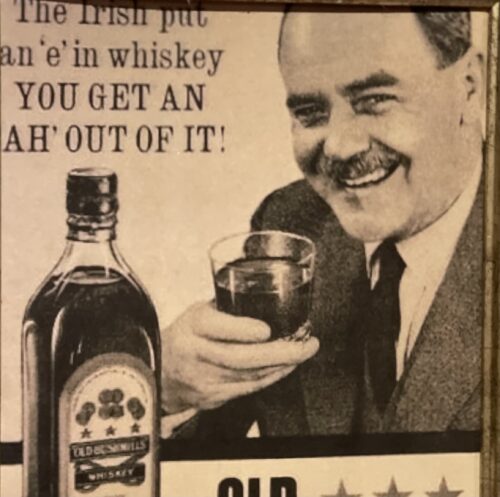
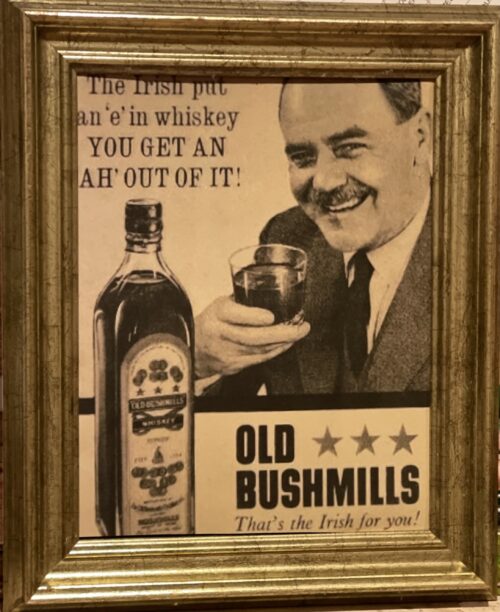 Classy advert depic 46cm x 33cm The Bushmills Old Distillery Company itself was not established until 1784 by Hugh Anderson.Bushmills suffered many lean years with numerous periods of closure with no record of the distillery being in operation in the official records both in 1802 and in 1822. In 1860 a Belfast spirit merchant named Jame McColgan and Patrick Corrigan bought the distillery; in 1880 they formed a limited company. In 1885, the original Bushmills buildings were destroyed by fire but the distillery was swiftly rebuilt. In 1890, a steamship owned and operated by the distillery, SS Bushmills, made its maiden voyage across the Atlantic to deliver Bushmills whiskey to America. It called at Philadelphia and New York City before heading on to Singapore, Hong Kong, Shanghai and Yokohama In the early 20th century, the U.S. was a very important market for Bushmills (and other Irish Whiskey producers). American Prohibition in 1920 came as a large blow to the Irish Whiskey industry, but Bushmills managed to survive. Wilson Boyd, Bushmills' director at the time, predicted the end of prohibition and had large stores of whiskey ready to export. After the Second World War, the distillery was bought by Isaac Wolfson, and, in 1972, it was taken over by Irish Distillers, meaning that Irish Distillers controlled the production of all Irish whiskey at the time. In June 1988, Irish Distillers was bought by French liquor group Pernod Ricard. In June 2005, the distillery was bought by Diageo for £200 million. Diageo have also announced a large advertising campaign in order to regain a market share for Bushmills. In May 2008, the Bank of Ireland issued a new series of sterling banknotes in Northern Ireland which all feature an illustration of the Old Bushmills Distillery on the obverse side, replacing the previous notes series which depicted Queen's University of Belfast. In November 2014 it was announced that Diageo had traded the Bushmills brand with Jose Cuervo in exchange for the 50% of the Don Julio brand of tequila that Diageo did not already own.
Classy advert depic 46cm x 33cm The Bushmills Old Distillery Company itself was not established until 1784 by Hugh Anderson.Bushmills suffered many lean years with numerous periods of closure with no record of the distillery being in operation in the official records both in 1802 and in 1822. In 1860 a Belfast spirit merchant named Jame McColgan and Patrick Corrigan bought the distillery; in 1880 they formed a limited company. In 1885, the original Bushmills buildings were destroyed by fire but the distillery was swiftly rebuilt. In 1890, a steamship owned and operated by the distillery, SS Bushmills, made its maiden voyage across the Atlantic to deliver Bushmills whiskey to America. It called at Philadelphia and New York City before heading on to Singapore, Hong Kong, Shanghai and Yokohama In the early 20th century, the U.S. was a very important market for Bushmills (and other Irish Whiskey producers). American Prohibition in 1920 came as a large blow to the Irish Whiskey industry, but Bushmills managed to survive. Wilson Boyd, Bushmills' director at the time, predicted the end of prohibition and had large stores of whiskey ready to export. After the Second World War, the distillery was bought by Isaac Wolfson, and, in 1972, it was taken over by Irish Distillers, meaning that Irish Distillers controlled the production of all Irish whiskey at the time. In June 1988, Irish Distillers was bought by French liquor group Pernod Ricard. In June 2005, the distillery was bought by Diageo for £200 million. Diageo have also announced a large advertising campaign in order to regain a market share for Bushmills. In May 2008, the Bank of Ireland issued a new series of sterling banknotes in Northern Ireland which all feature an illustration of the Old Bushmills Distillery on the obverse side, replacing the previous notes series which depicted Queen's University of Belfast. In November 2014 it was announced that Diageo had traded the Bushmills brand with Jose Cuervo in exchange for the 50% of the Don Julio brand of tequila that Diageo did not already own.







